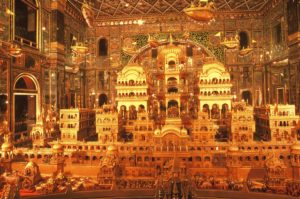Fault lines / bond lines – The case for India
Isn’t it natural that cracks appear over time, in physical objects, relationships, and even “social coherence”? Can we do something about this?
But now in India, some people are doing their best to encash any “social cracks” that appear from time to time. There is always a section of helpful media and media personalities with largely left-liberal education helping these elements. At times new fault lines are altogether ‘invented’ with great creativity. Some writers are engaged in planting propaganda articles/writeups in foreign publications like NYT or WaPo. Character assassination of India’s influential leaders/politicians/orators/opinion makers who strive for social unity and strengthening of the nation is a regular job of a few people.
The culture of India is a cohesion of hundreds of distinct and unique languages, religions, dance, music, architecture, food, and customs that differ from place to place within the country. Indian culture spans across the Indian subcontinent and extends into Southeast Asia and has been influenced by history and is several millennia old. Unfortunately, a section of people are leveraging these differences for “subversion”
A few observant citizens get infuriated at these deliberate jobs of vilifying the country and encouraging social disharmony, go on posting their disagreements which appears as ranting on SM, especially on Twitter (these posts being painted as “aggressive Indians” who have been traditionally characterized as soft and tolerant).
I first read about the concept of “Fault lines” from the book “Breaking India: Western Interventions in Dravidian and Dalit Faultlines” written by Rajiv Malhotra and Aravindan Neelakandan. The book studies forces that are active in fostering the separation of the identities of Dravidian and Dalit communities from the rest of India. Read about the book here: https://en.wikipedia.org/wiki/Breaking_India
And Barka Dutt’s “Unquiet Land: Stories From India’s Fault Lines” is using ‘fault lines theme’ to sell the book which intends to reinforce the cracks further
If “Fault lines” are natural phenomena. So are “Bonding/bond lines”. I wish to actively enhance these bond lines. It may take more prodding and effort to develop ‘bond lines’ than the easier task of creating ‘crack lines’
Dravida / Arya
- It is a mistake to classify the people into Aryan and Dravidian.
- Dravida comes from the word ‘Trivid’ meaning land of 3 seas. Adishankarachara a brahmin called himself a ‘Dravida sisu’
- In Sanskrit, Arya means, a citizen worthy of respect due to learning and behavior, (not in riches), and anaarya means, not worthy. Aryans are not people located in any particular part of the country or globe. “Pancha Dravida” is mentioned in our shastras as five Dravida groups. It’s common to say that Malayalam, Telugu, Tamil, and Kannada are Dravidian languages, our saastraas have included other groups also among the Pancha Dravidas
- Gurjaras
- Karnatakas
- Andhras
- Maharashtras
- Tamilians
- The British used these terms to divide people. We must acknowledge this and try to get over it in school education.
Sanskrit
- Sanskrit. Paramacharya of Kanchi in an exclusive interview to the illustrated Weekly of India on 11th August 1963, stated: “It (Sanskrit) is still a living language, in a recognizable form, in Thailand, Burma, Indonesia, Ceylon, and several other countries. When we adopt Sanskrit as the national language, we show our readiness to share the common heritage of all the South-East Asian countries, which will at once accept India as one among them. The Russian language also contains a number of words derived from Sanskrit. It is high time we raised our classical language to the status of a modern language for practical, utilitarian purposes. Meanwhile, let us not banish English from our hospitable land. It is a wonderful language, is it not? It is our only medium of communication with the outside world/”
- The Sahara desert was a sea, that dried up in course of time. The word‘Sagara’ possibly degenerated into ‘Sahara’.
- The 11 Egyptian pharaohs are called Ramesses and named after Ra (the ancient Egyptian sun god) which is considered the origin of the word Rama in Bharat, that is India. Ra (Agni beeja, the first agni being Sun,) the real king of earth? The words Regal, Reichland, Rajo (guna), Raja, and Rama all have origins in the word Ra. (Probably in India the sound ‘Ra’ is tempered by adding ‘Ma’ making Ra of Rama more lovable? Or Ma being the feminine, that always exists with masculine Ra)
Rama / Ramayana
- Rama, Sita, Lakshmana, Bharata, Hanuman, and Ravana are the characters of Ramayana and are fundamental to the cultural consciousness of not only India but also Nepal, Sri Lanka, and Thailand, Cambodia, Malaysia, and Indonesia.
- There are many versions of Ramayana in Indian languages, besides Buddhist, Sikh, and Jain adaptations. There are also Cambodian, Indonesian, Filipino, Thai, Lao, Burmese, and Malaysian versions of the tale.
- A grand Ayodhya temple complex with theme parks and museums keeping in mind all the languages/cultures of India / South Asia / South East Asia to be built along Sarayu will go a long way to improve intercultural and international relations and also contribute to peace and prosperity of the nation and region. This project seems to be feasible in the light of the recent Supreme court verdict. (Edited on 13 Nov 2019)

Gold carving depiction of the legendary Ayodhya at the Ajmer Jain temple.